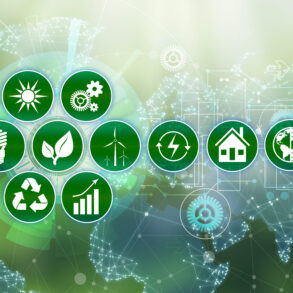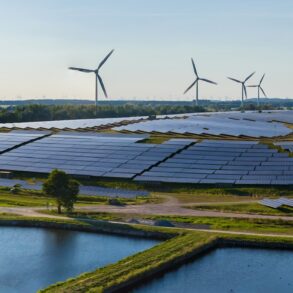Understand why Data Centers need renewable energy
7 minutes readingMore and more people – as well as more smart devices – are accessing the Internet daily, which makes the volume of data traffic grow faster than ever. Consequently, energy consumption increases progressively. And against this background, Data Center operators are being increasingly pressured to transition to using renewable energy 100% of the time.
This migration is an important goal, but not easily achieved. While the last decade has seen significant improvements in energy efficiency in the IT sector, much remains to be done.
The fact is that sustainability has become a fundamental issue for companies. Investors, customers, and policymakers increasingly demand carbon emissions reporting and 100% renewable energy use.
The truth is that organizations risk accusations of greenwashing if their renewable energy certificates are the primary (or only) component of their ESG strategies. Therefore, we are already seeing how to purchase agreements, such as ODATA’s recently announced partnership in an Omega Energia wind farm, are being used to obtain renewable energy for its operations.
See more below:
What is renewable energy?
As defined by the United Nations, renewable energy is energy derived from natural sources, which, in turn, are replenished at a rate greater than consumed. Sunlight and wind are good examples. Thus, it is understood that renewable energy sources are abundant and are all around us.
As common examples, renewable energy can be used for electricity generation, space heating and cooling, water and transportation.
On the other hand, fossil fuels – such as coal, oil and gas – are non-renewable resources that take hundreds of millions of years to form. And these elements, when burned to produce energy, cause harmful emissions of greenhouse gases such as carbon dioxide.

Benefits of renewable energy
The advantages of renewable energy are numerous and favour the economy, the environment, national security and human health. This model is now cheaper in most countries and generates three times more jobs than fossil fuels.
In fact, renewable energy generates much lower emissions than burning fossil fuels. For this reason, transitioning from fossil fuels (which currently account for most CO² emissions into the atmosphere) to renewable energy sources is essential for tackling the climate crisis.
In addition to these benefits of using renewable energy, we can also highlight the following:
- More excellent reliability, security and resilience of the country’s electrical grid;
- Job creation across all renewable energy industries;
- Reduction of carbon emissions and air pollution in energy production;
- Greater energy independence;
- Greater affordability, as many types of renewable energy are cost-competitive with traditional energy sources;
- Access to clean energy for remote communities.
Types of renewable energy
Renewable energy sources such as biomass, geothermal resources, sunlight, water and wind are natural resources that can be converted into these types of clean, reusable energy. Among them, we can highlight the following:
- Bioenergy
- Geothermal energy
- Hydroelectric
- Hydrogen
- Marine Energy
- Solar energy
- Wind energy
Although solar energy is the most plentiful of all energy resources and can be used even on cloudy days, the abundance of wind makes wind energy one of the most promising alternative energy sources. For example, the Global Wind Energy Council estimated that this model could satisfy 20% of global electricity demand by 2030.
The scenario of renewable energy in Brazil
According to a survey by Mordor Intelligence, the Brazilian renewable energy market is expected to register a compound annual growth rate (CAGR) of more than 3.8% between 2022 and 2027.
Factors such as increased investments and developments in the wind energy sector, as well as supportive government policies, are expected to drive the market during the forecast period. The wind energy segment is expected to grow significantly due to the focus on offshore and onshore wind energy projects.
According to the consultancy, Brazil aims to exceed its installed renewable energy capacity to 60 GW by 2030. Therefore, such growth is expected to provide ample opportunities in the coming years, boosting the Brazilian renewable energy market during the forecast period.
In practice, the country is already one of the most advanced in Latin America concerning the development of the renewable energy sector. For example, it gathers excellent levels of solar radiation, as it is in a latitude range in which the incidence of radiation is much higher than in the rest of the world.
According to IRENA, the total installed renewable energy capacity was 150 GW in 2020, with a year-on-year growth of 4.2% compared to the previous year (2019). In this vein, the installation capacity increase is expected to boost the Brazilian renewable energy market.
In 2022, Brazil had 181,532.7 MW of authorized power, of which 82.96% came from renewable sources. Wind farms represented 11.41% of the country’s total installed capacity, while solar energy represented 2.53%. Large hydroelectric plants (UHE), small hydroelectric plants (PCHs) and mini-hydroelectric plants (CGH) represented 56.20%, 3.03% and 0.46% of the total installed capacity, respectively, according to the regulatory agency ANEEL and the Official Gazette of Unity.
Furthermore, despite Brazil’s unfavourable economic and political scenario in recent years, the renewable energy market continues to grow and attract international players. Today, the Brazilian government regulates several policies to entice national and foreign investments in renewable projects.
Energy consumption in Data Centers
The Data Center market is proliferating – experts predict the sector will grow at least 18% by 2025. But the rise is not the only challenge that companies in this segment face today.
As new and emerging technologies such as artificial intelligence and 5G drive energy demand, customers demand that the industry operate more sustainably by reducing its consumption and transitioning to more sustainable energy sources.
To this end, the industry needs a sensible path to building sustainable data centers while not compromising its ability to provide high-quality services to customers.
Despite being one of the types of buildings with the highest energy consumption, the sector is already making great strides towards implementing and promoting more sustainable practices, mainly through implementing cutting-edge technologies and using clean and renewable energy sources.
Undoubtedly, one of the most efficient ways to reduce the environmental impact of Data Centers is to replace traditional energy sources with other renewable energy options.
Furthermore, this model even offers an alternative to the often fluctuating prices of more conventional fuels.
READ MORE: Understand why Data Center outsourcing can improve your company’s sustainability rates
ODATA: Data Centers powered by renewable energy
In partnership with Omega Energia, a reference company in renewable energy investments in the Americas, ODATA has just announced the acquisition of a minority stake in the Assuruá IV wind farm (212 MW), located in Brazil, in the city of Xique-Xique (Bahia).
Therefore, ODATA became the first hyperscale Data Center provider in Latin America to have 100% of the energy consumption of its buildings coming from direct participation in renewable sources. The agreement reinforces the company’s mission to improve the region’s digital infrastructure with the highest sustainability standards.
Closing of the transaction is subject to certain customary conditions precedent, including, among others, approval by the Administrative Council for Economic Defense – CADE.
Through this initiative, the company will stop emitting approximately 125,000 tons of carbon dioxide (CO2) into the atmosphere by 2035.
“Our commitment to ESG has been going on for a long time, and now we are taking another step forward by signing this renewable energy consumption agreement through a partnership in an Omega Energia wind farm,” explains Ricardo Alário, co-founder and president of ODATA.
Considering our strong growth and high energy demand, we must partner with great partners with specific expertise to offer sustainable solutions to our customers”.
“We are excited about this partnership with ODATA. By finding partners who share the same purpose as Omega, we are committed to perpetuating business relationships. We always seek to develop customized, innovative and technological solutions to build a society that aligns with sustainability criteria,” says Fabiana Polido, commercial director at Omega Energia.
“In addition to all of Omega’s history on fronts that focus on clean energy and competitiveness, it is very inspiring to work on projects with teams that celebrate achievements like this”, adds Mariana Fulan, the company’s commercial manager.
“A strategy focused on energy efficiency and renewable energy are differentials in our sector and essential for our society. With increasing digitalization and climate change, it is essential to have zero carbon energy sources, and wind energy becomes one of the best options for achieving our ESG goals, contributing to the fight against climate change and the Development Goals UN Sustainable Development”, explains Carolina Maestri, Director of ESG at ODATA.
ODATA is present in four countries in Latin America (Brazil, Colombia, Mexico and Chile), and its sites have approximately 460 MW of IT capacity. Considering that Data Centers are significant energy consumers, with this initiative, the company ensures that 100% of its consumption in Brazil comes from clean energy.
Do you want to know how your Data Center can benefit from renewable energy consumption?
Exclusive E-BOOKS
to help you learn more about the world of colocation.

Related Posts
SUBSCRIBE TO OUR NEWSLETTER





